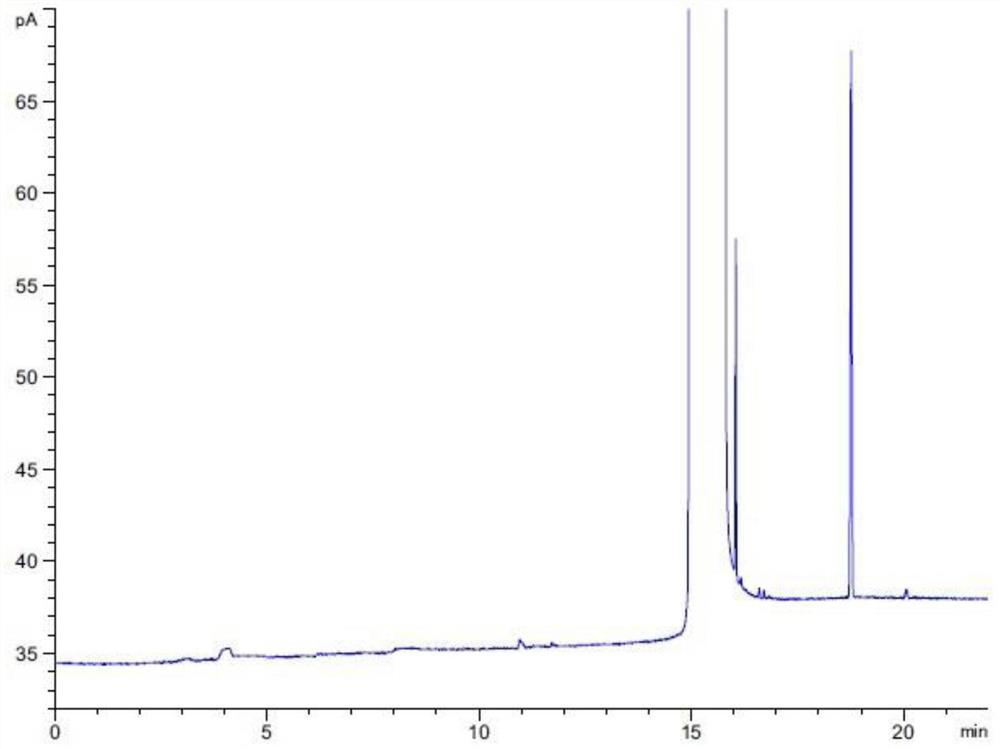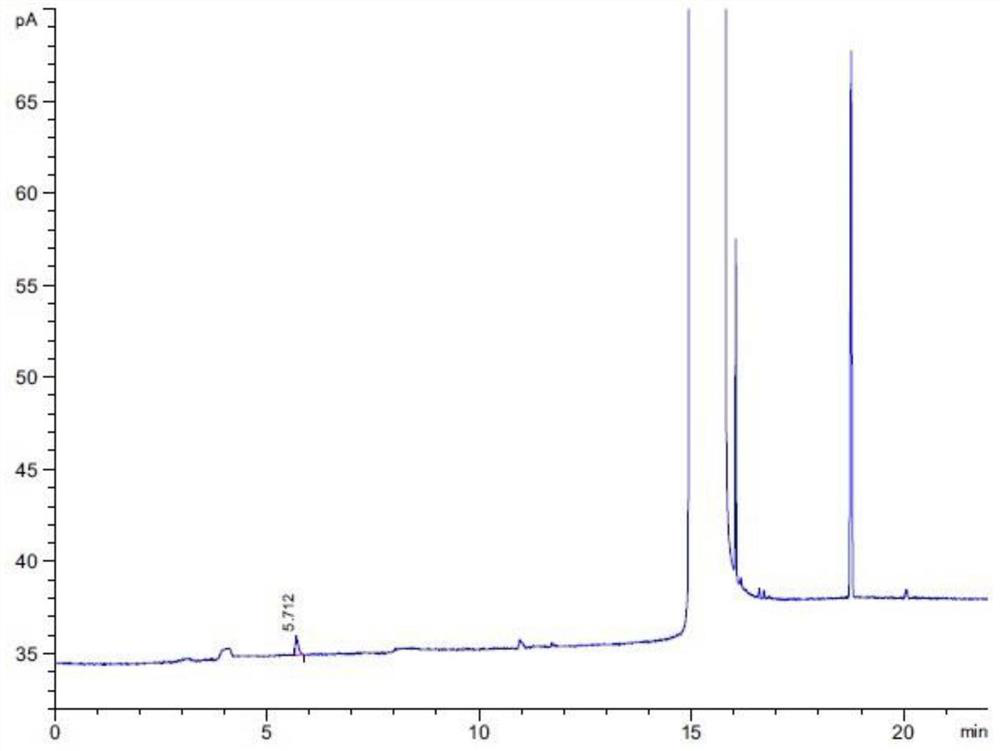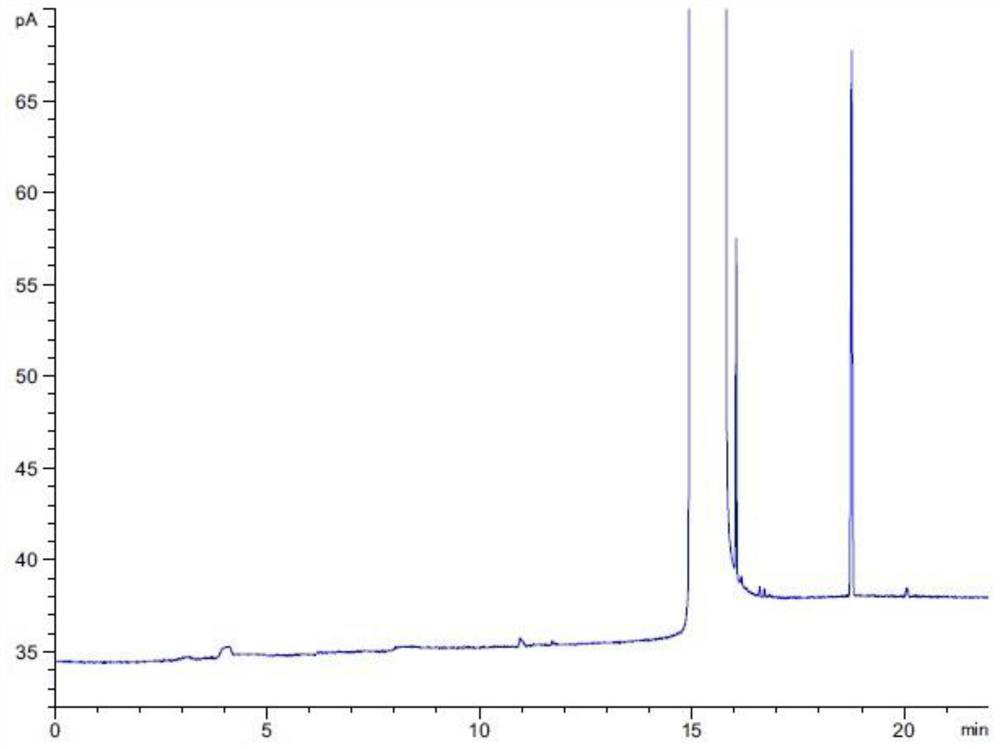Method for determining genotoxic substance ethyl chloroformate in loratadine by using gas chromatography
A technology of ethyl chloroformate and gas chromatography, which is applied in the field of separation and determination of genotoxic ethyl chloroformate in loratadine by gas chromatography, and can solve problems such as incomplete removal of genotoxic substances and affecting drug safety
- Summary
- Abstract
- Description
- Claims
- Application Information
AI Technical Summary
Problems solved by technology
Method used
Image
Examples
Embodiment 1
[0036]Apparatus and conditions
[0037]Chromatograph: Agilent 6890N gas chromatograph;
[0038]Detector: hydrogen flame ionization detector;
[0039]Column: Polyethylene glycol polar capillary column;
[0040]Inlet temperature: 220℃;
[0041]Detector temperature: 300℃;
[0042]Carrier gas (nitrogen) flow rate: 1.0mL / min;
[0043]Split ratio: 5:1;
[0044]Injection volume: 1μL
[0045]Oven heating program:
[0046] Heating rate (℃ / min) Temperature (℃) Holding time (min) / 500 102005
[0047]Experimental steps
[0048]Take 100mg~200mg of loratadine, add 1.0mL solvent, shake well, sonicate, centrifuge, take the supernatant as the test solution; take an appropriate amount of ethyl chloroformate, dissolve it with a solvent, and make up to 1mL Ethyl chloroformate 9.5~19.0mg reference substance solution; take another 100mg~200mg of loratadine, add 1.0mL reference substance solution, shake well, ultrasound, centrifuge, take the supernatant, make up every 1mL containing ethyl chloroformate System suitability solution of est...
Embodiment 2
[0050]Apparatus and conditions
[0051]Chromatograph: Agilent 6890N gas chromatograph;
[0052]Detector: hydrogen flame ionization detector;
[0053]Column: Polyethylene glycol polar capillary column;
[0054]Inlet temperature: 220℃;
[0055]Detector temperature: 300℃;
[0056]Carrier gas (nitrogen) flow rate: 1.2mL / min;
[0057]Split ratio: 5:1;
[0058]Injection volume: 1μL
[0059]Oven heating program:
[0060] Heating rate (℃ / min) Temperature (℃) Holding time (min) / 500 102005
[0061]Experimental steps
[0062]Take an appropriate amount of ethyl chloroformate and dissolve it with a solvent to prepare a reference solution containing 9.5-19.0mg of ethyl chloroformate per 1mL; take another 100mg~200mg of loratadine, add 1.0mL reference solution, and shake well , Sonication, centrifugation, take the supernatant and prepare a system suitability solution containing 9.5-19.0mg of ethyl chloroformate per 1mL. Take the system suitability solution, analyze according to the above chromatographic conditions, and record t...
Embodiment 3
[0064]Apparatus and conditions
[0065]Chromatograph: Agilent 6890N gas chromatograph;
[0066]Detector: hydrogen flame ionization detector;
[0067]Column: Polyethylene glycol polar capillary column;
[0068]Inlet temperature: 220℃;
[0069]Detector temperature: 300℃;
[0070]Carrier gas (nitrogen) flow rate: 1.0mL / min;
[0071]Split ratio: 10:1;
[0072]Injection volume: 1μL
[0073]Oven heating program:
[0074] Heating rate (℃ / min) Temperature (℃) Holding time (min) / 500 102005
[0075]Experimental steps
[0076]Take 100mg~200mg of loratadine, add 1.0mL of reference solution, shake well, ultrasound, centrifuge, take the supernatant, and prepare a system-suitable solution containing 9.5~19.0mg of ethyl chloroformate per 1mL. Take the system suitability solution, analyze according to the above chromatographic conditions, and record the chromatogram. The results are attachedFigure 6 , The chromatographic peak with retention time 5.703 min in the figure is ethyl chloroformate.
[0077]The present invention verifies t...
PUM
 Login to View More
Login to View More Abstract
Description
Claims
Application Information
 Login to View More
Login to View More - R&D
- Intellectual Property
- Life Sciences
- Materials
- Tech Scout
- Unparalleled Data Quality
- Higher Quality Content
- 60% Fewer Hallucinations
Browse by: Latest US Patents, China's latest patents, Technical Efficacy Thesaurus, Application Domain, Technology Topic, Popular Technical Reports.
© 2025 PatSnap. All rights reserved.Legal|Privacy policy|Modern Slavery Act Transparency Statement|Sitemap|About US| Contact US: help@patsnap.com



